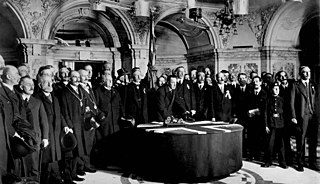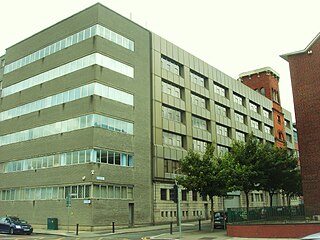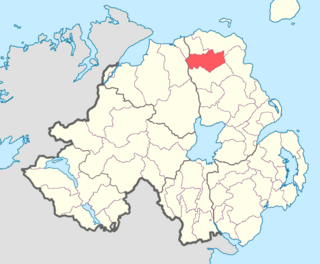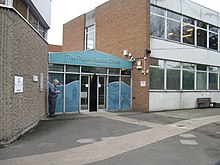
Belfast is the capital city and principal port of Northern Ireland, standing on the banks of the River Lagan and connected to the open sea through Belfast Lough and the North Channel. It is second to Dublin as the largest city on the island of Ireland with a population in 2021 of 345,418 and a metro area population of 671,559.

Harland & Wolff is a British shipbuilding and fabrication company headquartered in London with sites in Belfast, Arnish, Appledore and Methil. It specialises in ship repair, shipbuilding and offshore construction. Harland & Wolff is famous for having built the majority of the ocean liners for the White Star Line, including Olympic-class trio – RMS Olympic, RMS Titanic and HMHS Britannic. Outside of White Star Line, other ships that have been built include the Royal Navy's HMS Belfast; Royal Mail Line's Andes; Shaw, Savill & Albion's Southern Cross; Union-Castle's RMS Pendennis Castle; P&O's Canberra; and Hamburg-America's SS Amerika of 1905. Harland and Wolff's official history, Shipbuilders to the World, was published in 1986.

Thomas Andrews Jr. was a British businessman and shipbuilder. He was managing director and head of the drafting department of the shipbuilding company Harland and Wolff in Belfast, Ireland.

Ulster's Solemn League and Covenant, commonly known as the Ulster Covenant, was signed by nearly 500,000 people on and before 28 September 1912, in protest against the Third Home Rule Bill introduced by the British Government in the same year.

The Ulster Folk Museum and Ulster Transport Museum are situated in Cultra, Northern Ireland, about 11 kilometres (6.8 mi) east of the city of Belfast. The Folk Museum endeavours to illustrate the way of life and traditions of the people in Northern Ireland, past and present, while the Transport Museum explores and exhibits methods of transport by land, sea and air, past and present. The museums rank among Ireland's foremost visitor attractions and is a former Irish Museum of the Year. The location houses two of four museums included in National Museums Northern Ireland.

The Odyssey Complex, consisting of Odyssey Place and the SSE Arena, is a sports, entertainment and science learning complex located within the Titanic Quarter in Belfast, Northern Ireland.

HMS Caroline is a decommissioned C-class light cruiser of the Royal Navy that saw combat service in the First World War and served as an administrative centre in the Second World War. Caroline was launched and commissioned in 1914. At the time of her decommissioning in 2011 she was the second-oldest ship in Royal Navy service, after HMS Victory. She served as a static headquarters and training ship for the Royal Naval Reserve, based in Alexandra Dock, Belfast, Northern Ireland, for the later stages of her career. She was converted into a museum ship. From October 2016 she underwent inspection and repairs to her hull at Harland and Wolff and opened to the public on 1 July 2017 at Alexandra Dock in the Titanic Quarter in Belfast.

Belfast Harbour is a major maritime hub in Belfast, Northern Ireland, handling 67% of Northern Ireland's seaborne trade and about 25% of the maritime trade of the entire island of Ireland. It is a vital gateway for raw materials, exports and consumer goods, and is also Northern Ireland's leading logistics and distribution hub.

Belfast City Hall is the civic building of Belfast City Council located in Donegall Square, Belfast, Northern Ireland. It faces North and effectively divides the commercial and business areas of the city centre. It is a Grade A listed building.

Coagh is a small village in County Tyrone, Northern Ireland, five miles (8 km) east of Cookstown. Part of the village also extends into County Londonderry. It had a population of 545 people in the 2001 Census. It owes its existence to George Butle Conyngham of Springhill, and was founded in 1728 when King George II of Great Britain granted Conyngham a market charter allowing the village to host four fairs yearly. It is situated within Mid-Ulster District.
Health and Social Care (HSC) is the publicly funded healthcare system in Northern Ireland. Although having been created separately to the National Health Service (NHS), it is nonetheless considered a part of the overall national health service in the United Kingdom. The Northern Ireland Executive through its Department of Health is responsible for its funding, while the Public Health Agency is the executive agency responsible for the provision of public health and social care services across Northern Ireland. It is free of charge to all citizens of Northern Ireland and the rest of the United Kingdom.

The National Archives of Ireland is the official repository for the state records of Ireland. Established by the National Archives Act 1986, taking over the functions of the State Paper Office and the Public Record Office of Ireland. In 1991, the National Archives moved to its current premises in Bishop Street, Dublin. The Archives stand on the site of the Jacob's Factory, one of the garrisons held by rebels during the 1916 Easter Rising.

Titanic Quarter in Belfast, Northern Ireland, is a large-scale waterfront regeneration, comprising historic maritime landmarks, film studios, education facilities, apartments, a riverside entertainment district, and the world's largest Titanic-themed attraction centred on land in Belfast Harbour, known until 1995 as Queen's Island. The 185-acre (75 ha) site, previously occupied by part of the Harland and Wolff shipyard, is named after the company's, and the city's, most famous product, RMS Titanic. Titanic Quarter is part of the Dublin-based group, Harcourt Developments, which has held the development rights since 2003.
The General Register Office (GRO) is responsible for the civil registration of births, deaths, marriages, civil partnerships and adoptions as well as administering marriage and civil partnership law in Northern Ireland. The GRO is within the Northern Ireland Statistics and Research Agency which in turn is part of the Northern Ireland Executive's Department of Finance. Its main office is at Colby House, Stranmillis Court, Belfast.

Northern Ireland Screen is the national screen agency for Northern Ireland. The agency's purpose is to promote the development of a sustainable film, animation and television production industry.

TitanicBelfast is a visitor attraction opened in 2012, a monument to Belfast's maritime heritage on the site of the former Harland & Wolff shipyard in the city's Titanic Quarter where the RMS Titanic was built. It tells the stories of the Titanic, which hit an iceberg and sank during her maiden voyage in 1912, and her sister ships RMS Olympic and HMHS Britannic. The building contains more than 12,000 square metres (130,000 sq ft) of floor space, most of which is occupied by a series of galleries, private function rooms and community facilities.

Dunluce Upper is a barony in County Antrim, Northern Ireland. It is bordered by six other baronies: Dunluce Lower to the north; Cary to the north-east; North East Liberties of Coleraine to the north-west; Coleraine to the west; Kilconway to the south; and Glenarm Lower to the east. Dunluce Upper also formed part of the medieval territory known as the Route.

Carrickfergus is a barony in County Antrim, Northern Ireland. It is bounded on the south-east by Belfast Lough, and otherwise surrounded by the barony of Belfast Lower. It is coextensive with the civil parish of Carrickfergus or St Nicholas and corresponds to the former county of the town of Carrickfergus, a county corporate encompassing Carrickfergus town.

The Arc is a residential development located beside Abercorn Basin in the Titanic Quarter of Belfast, Northern Ireland. It contains 474 residential properties, a hotel, and a number of retail units, split across three buildings. The name "Arc" is an abbreviation for Abercorn Residential Complex, and also refers to the curved design of the buildings.




















